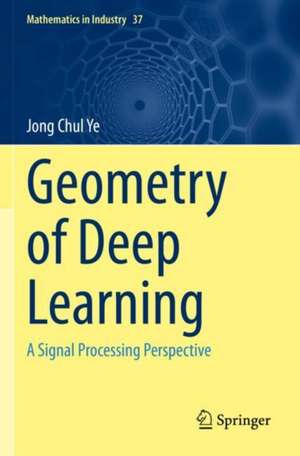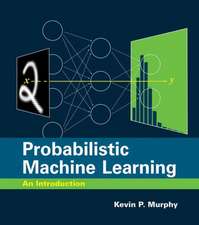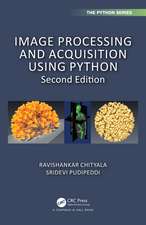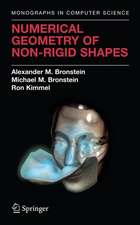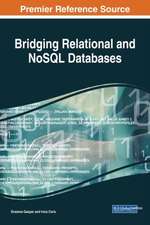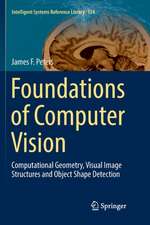Geometry of Deep Learning: A Signal Processing Perspective: Mathematics in Industry, cartea 37
Autor Jong Chul Yeen Limba Engleză Paperback – 7 ian 2023
To support this claim, an overview of classical kernel machine learning approaches is presented, and their advantages and limitations are explained. Following a detailed explanation of the basic building blocks of deep neural networks from a biological and algorithmic point of view, the latest tools such as attention, normalization, Transformer, BERT, GPT-3, and others are described. Here, too, the focus is on the fact that in these heuristic approaches, there is an important, beautiful geometric structure behind the intuition that enables a systematic understanding. A unified geometric analysis to understand the working mechanism of deep learning from high-dimensional geometry is offered. Then, different forms of generative models like GAN, VAE, normalizing flows, optimal transport, and so on are described from a unified geometric perspective, showing that they actually come from statistical distance-minimization problems.
Because this book contains up-to-date information from both a practical and theoretical point of view, it can be used as an advanced deep learning textbook in universities or as a reference source for researchers interested in acquiring the latest deep learning algorithms and their underlying principles. In addition, the book has been prepared for a codeshare course for both engineering and mathematics students, thus much of the content is interdisciplinary and will appeal to students from both disciplines.
| Toate formatele și edițiile | Preț | Express |
|---|---|---|
| Paperback (1) | 426.30 lei 6-8 săpt. | |
| Springer Nature Singapore – 7 ian 2023 | 426.30 lei 6-8 săpt. | |
| Hardback (1) | 388.27 lei 3-5 săpt. | +30.86 lei 6-10 zile |
| Springer Nature Singapore – 6 ian 2022 | 388.27 lei 3-5 săpt. | +30.86 lei 6-10 zile |
Din seria Mathematics in Industry
- 20%
 Preț: 567.11 lei
Preț: 567.11 lei - 18%
 Preț: 1045.68 lei
Preț: 1045.68 lei - 15%
 Preț: 650.86 lei
Preț: 650.86 lei - 13%
 Preț: 388.27 lei
Preț: 388.27 lei - 18%
 Preț: 1010.48 lei
Preț: 1010.48 lei - 18%
 Preț: 1247.26 lei
Preț: 1247.26 lei - 18%
 Preț: 982.87 lei
Preț: 982.87 lei - 15%
 Preț: 646.62 lei
Preț: 646.62 lei - 18%
 Preț: 959.50 lei
Preț: 959.50 lei - 18%
 Preț: 953.35 lei
Preț: 953.35 lei - 15%
 Preț: 642.36 lei
Preț: 642.36 lei - 15%
 Preț: 643.34 lei
Preț: 643.34 lei - 18%
 Preț: 1020.74 lei
Preț: 1020.74 lei - 18%
 Preț: 962.81 lei
Preț: 962.81 lei - 18%
 Preț: 790.28 lei
Preț: 790.28 lei - 24%
 Preț: 825.72 lei
Preț: 825.72 lei -
 Preț: 499.83 lei
Preț: 499.83 lei - 15%
 Preț: 642.03 lei
Preț: 642.03 lei - 18%
 Preț: 1234.46 lei
Preț: 1234.46 lei - 15%
 Preț: 640.88 lei
Preț: 640.88 lei - 18%
 Preț: 1238.56 lei
Preț: 1238.56 lei - 15%
 Preț: 634.49 lei
Preț: 634.49 lei - 15%
 Preț: 642.18 lei
Preț: 642.18 lei - 15%
 Preț: 661.02 lei
Preț: 661.02 lei - 24%
 Preț: 793.16 lei
Preț: 793.16 lei - 15%
 Preț: 648.42 lei
Preț: 648.42 lei - 15%
 Preț: 653.79 lei
Preț: 653.79 lei - 24%
 Preț: 1046.75 lei
Preț: 1046.75 lei - 18%
 Preț: 1399.24 lei
Preț: 1399.24 lei - 18%
 Preț: 943.25 lei
Preț: 943.25 lei
Preț: 426.30 lei
Nou
Puncte Express: 639
Preț estimativ în valută:
81.57€ • 88.88$ • 68.74£
81.57€ • 88.88$ • 68.74£
Carte tipărită la comandă
Livrare economică 23 aprilie-07 mai
Preluare comenzi: 021 569.72.76
Specificații
ISBN-13: 9789811660481
ISBN-10: 9811660484
Pagini: 330
Ilustrații: XVI, 330 p. 1 illus.
Dimensiuni: 155 x 235 x 22 mm
Greutate: 0.49 kg
Ediția:1st ed. 2022
Editura: Springer Nature Singapore
Colecția Springer
Seria Mathematics in Industry
Locul publicării:Singapore, Singapore
ISBN-10: 9811660484
Pagini: 330
Ilustrații: XVI, 330 p. 1 illus.
Dimensiuni: 155 x 235 x 22 mm
Greutate: 0.49 kg
Ediția:1st ed. 2022
Editura: Springer Nature Singapore
Colecția Springer
Seria Mathematics in Industry
Locul publicării:Singapore, Singapore
Cuprins
Part I Basic Tools for Machine Learning: 1. Mathematical Preliminaries.- 2. Linear and Kernel Classifiers.- 3. Linear, Logistic, and Kernel Regression.- 4. Reproducing Kernel Hilbert Space, Representer Theorem.- Part II Building Blocks of Deep Learning: 5. Biological Neural Networks.- 6. Artificial Neural Networks and Backpropagation.- 7. Convolutional Neural Networks.- 8. Graph Neural Networks.- 9. Normalization and Attention.- Part III Advanced Topics in Deep Learning.- 10. Geometry of Deep Neural Networks.- 11. Deep Learning Optimization.- 12. Generalization Capability of Deep Learning.- 13. Generative Models and Unsupervised Learning.- Summary and Outlook.- Bibliography.- Index.
Recenzii
“This book is based on material that has been prepared for senior-level undergraduate classes, this book can be used for one-semester senior-level undergraduate and graduate-level classes.” (Arzu Ahmadova, zbMATH 1493.68003, 2022)
Notă biografică
The author is currently a full Professor at Korea Advanced Institute of Science and Technology (KAIST). Also he has been a Fellow of IEEE since January 2020.
Textul de pe ultima copertă
The focus of this book is on providing students with insights into geometry that can help them understand deep learning from a unified perspective. Rather than describing deep learning as an implementation technique, as is usually the case in many existing deep learning books, here, deep learning is explained as an ultimate form of signal processing techniques that can be imagined.
To support this claim, an overview of classical kernel machine learning approaches is presented, and their advantages and limitations are explained. Following a detailed explanation of the basic building blocks of deep neural networks from a biological and algorithmic point of view, the latest tools such as attention, normalization, Transformer, BERT, GPT-3, and others are described. Here, too, the focus is on the fact that in these heuristic approaches, there is an important, beautiful geometric structure behind the intuition that enables a systematic understanding. A unified geometric analysis to understand the working mechanism of deep learning from high-dimensional geometry is offered. Then, different forms of generative models like GAN, VAE, normalizing flows, optimal transport, and so on are described from a unified geometric perspective, showing that they actually come from statistical distance-minimization problems.
Because this book contains up-to-date information from both a practical and theoretical point of view, it can be used as an advanced deep learning textbook in universities or as a reference source for researchers interested in acquiring the latest deep learning algorithms and their underlying principles. In addition, the book has been prepared for a codeshare course for both engineering and mathematics students, thus much of the content is interdisciplinary and will appeal to students from both disciplines.
Because this book contains up-to-date information from both a practical and theoretical point of view, it can be used as an advanced deep learning textbook in universities or as a reference source for researchers interested in acquiring the latest deep learning algorithms and their underlying principles. In addition, the book has been prepared for a codeshare course for both engineering and mathematics students, thus much of the content is interdisciplinary and will appeal to students from both disciplines.
Caracteristici
Covers recent developments in deep learning and a wide spectrum of issues, with exercise problems for students Employs unified mathematical approaches with illustrative graphics to present various techniques and their results Closes the gap between the purely mathematical and implementation-oriented treatments of deep learning
